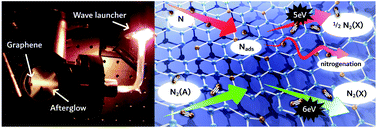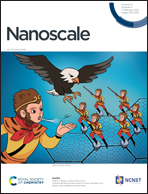Incorporation-limiting mechanisms during nitrogenation of monolayer graphene films in nitrogen flowing afterglows†
Abstract
Monolayer graphene films are exposed to the flowing afterglow of a low-pressure microwave nitrogen plasma, characterized by the absence of ion irradiation and significant populations of N atoms and N2(A) metastables. Hyperspectral Raman imaging of graphene domains reveals damage generation with a progressive rise of the D/G and D/2D band ratios following subsequent plasma treatments. Plasma-induced damage is mostly zero-dimensional and the graphene state remains in the pre-amorphous regime. Over the range of experimental conditions investigated, damage formation increases with the fluence of energy provided by heterogenous surface recombination of N atoms and deexcitation of N2(A) metastable species. In such conditions, X-ray photoelectron spectroscopy reveals that the nitrogen incorporation (either as pyridine, pyrrole, or quaternary moieties) does not simply increase with the fluence of plasma-generated N atoms but is also linked to the damage generation. Based on these findings, a surface reaction model for monolayer graphene nitrogenation is proposed. It is shown that the nitrogen incorporation is first limited by the plasma-induced formation of defect sites at low damage and then by the adsorption of nitrogen atoms at high damage.

- This article is part of the themed collection: Chemistry of 2D materials: graphene and beyond


 Please wait while we load your content...
Please wait while we load your content...